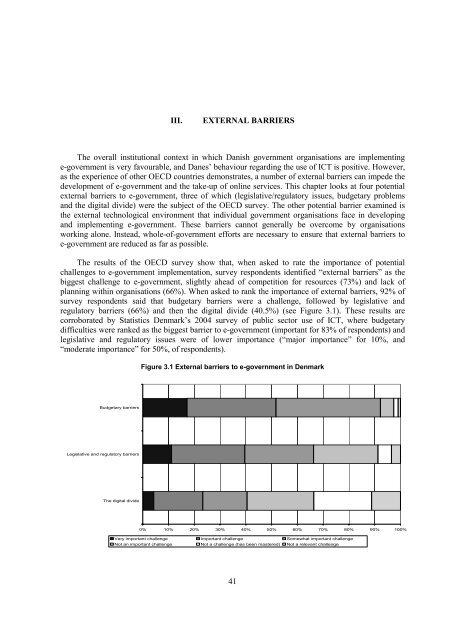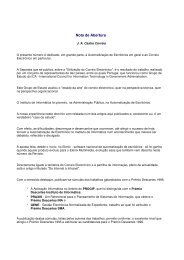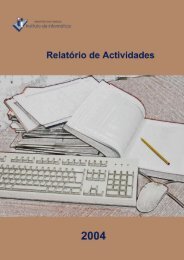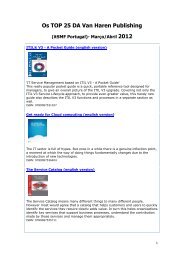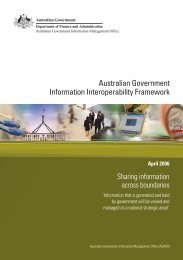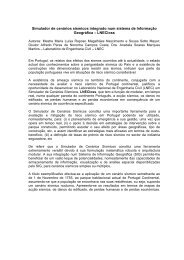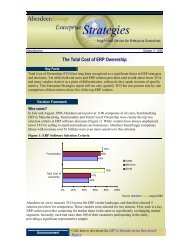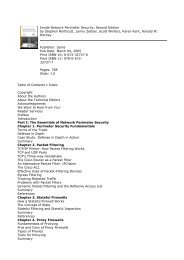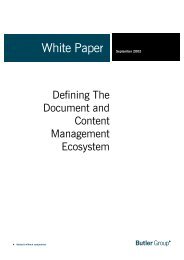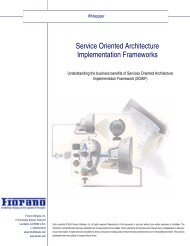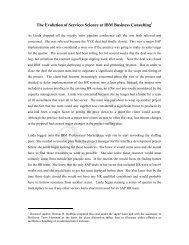OECD Peer Review of E-Government in Denmark - ePractice.eu
OECD Peer Review of E-Government in Denmark - ePractice.eu
OECD Peer Review of E-Government in Denmark - ePractice.eu
You also want an ePaper? Increase the reach of your titles
YUMPU automatically turns print PDFs into web optimized ePapers that Google loves.
III.<br />
EXTERNAL BARRIERS<br />
The overall <strong>in</strong>stitutional context <strong>in</strong> which Danish government organisations are implement<strong>in</strong>g<br />
e-government is very favourable, and Danes’ behaviour regard<strong>in</strong>g the use <strong>of</strong> ICT is positive. However,<br />
as the experience <strong>of</strong> other <strong>OECD</strong> countries demonstrates, a number <strong>of</strong> external barriers can impede the<br />
development <strong>of</strong> e-government and the take-up <strong>of</strong> onl<strong>in</strong>e services. This chapter looks at four potential<br />
external barriers to e-government, three <strong>of</strong> which (legislative/regulatory issues, budgetary problems<br />
and the digital divide) were the subject <strong>of</strong> the <strong>OECD</strong> survey. The other potential barrier exam<strong>in</strong>ed is<br />
the external technological environment that <strong>in</strong>dividual government organisations face <strong>in</strong> develop<strong>in</strong>g<br />
and implement<strong>in</strong>g e-government. These barriers cannot generally be overcome by organisations<br />
work<strong>in</strong>g alone. Instead, whole-<strong>of</strong>-government efforts are necessary to ensure that external barriers to<br />
e-government are reduced as far as possible.<br />
The results <strong>of</strong> the <strong>OECD</strong> survey show that, when asked to rate the importance <strong>of</strong> potential<br />
challenges to e-government implementation, survey respondents identified “external barriers” as the<br />
biggest challenge to e-government, slightly ahead <strong>of</strong> competition for resources (73%) and lack <strong>of</strong><br />
plann<strong>in</strong>g with<strong>in</strong> organisations (66%). When asked to rank the importance <strong>of</strong> external barriers, 92% <strong>of</strong><br />
survey respondents said that budgetary barriers were a challenge, followed by legislative and<br />
regulatory barriers (66%) and then the digital divide (40.5%) (see Figure 3.1). These results are<br />
corroborated by Statistics <strong>Denmark</strong>’s 2004 survey <strong>of</strong> public sector use <strong>of</strong> ICT, where budgetary<br />
difficulties were ranked as the biggest barrier to e-government (important for 83% <strong>of</strong> respondents) and<br />
legislative and regulatory issues were <strong>of</strong> lower importance (“major importance” for 10%, and<br />
“moderate importance” for 50%, <strong>of</strong> respondents).<br />
Figure 3.1 External barriers to e-government <strong>in</strong> <strong>Denmark</strong><br />
Budgetary barriers<br />
Legislative and regulatory barriers<br />
The digital divide<br />
0% 10% 20% 30% 40% 50% 60% 70% 80% 90% 100%<br />
Very important challenge Important challenge Somewhat important challenge<br />
Not an important challenge Not a challenge (has been mastered) Not a relevant challenge<br />
41


